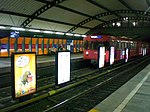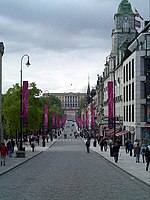Sagene Line

The Sagene Line (Norwegian: Sagenelinjen) is an abandoned line of the Oslo Tramway in Norway. It ran from Stortorvet in the city center along Akersgata and Ullevålsveien through the neighborhood of St. Hanshaugen. It then continued along Colletts gate, Geitmyrsveien and Kierschouws gate to Sagene. At Sagene Church it had a regulation stop and access to Sagene Depot. The line continued along Bentsebrugata to Torshov, where it intersected with the Grünerløkka–Torshov Line. The line was the first tramway opened by Kristiania Kommunale Sporveie (KKS), on 24 November 1899. Originally the line ran from Athenæum to Sagene Church. The company and the line were taken over by Kristiania Sporveisselskab (KSS) in 1905. The line was expanded on 28 December 1914 with the connection to Torshov. From 1915 Sagene was served by Sagene Ring, a circle line service which combined the Sagene Line with the Grünerløkka–Torshov Line. Operations were taken over by Oslo Sporveier in 1924. From that year until 1949 there was a branch line from Bentsebrugata, the Korsvoll Line. Services on the Sagene Ring terminated in 1957. As part of a planned closing of the tramway, the Sinsen Line from Stortorvet to Sagene was closed in 1966. Services remained from Sagene to Torshov until 1998.
Excerpt from the Wikipedia article Sagene Line (License: CC BY-SA 3.0, Authors, Images).Sagene Line
Akersgata, Oslo Sentrum
Geographical coordinates (GPS) Address Phone number Website Nearby Places Show on map
Geographical coordinates (GPS)
| Latitude | Longitude |
|---|---|
| N 59.914 ° | E 10.7426 ° |
Address
Cubus
Akersgata
0159 Oslo, Sentrum
Norway
Open on Google Maps









